BRCC-2014-Writeup
Blue Ribbon CEO Conclave: BUSINESS PRACTICES FOR NEXT GENERATION MOBILITY
Summary by: Dr. Arun Jaura, Chairman, Automotive Board, SAEINDIA
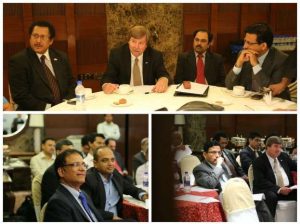
Blue Ribbon CEO Conclave on July 25, 2014
In India, like many other emerging nations, the projected growth in urban development is coupled with the challenge of providing and managing movement of people and goods in inner cities. For businesses, this is a huge opportunity to integrate and deploy smart solutions to ease congestion, enhance safety and ensure efficient energy management for CO2 reduction. A holistic deployment will require agility and a mindset change to proactively review the current state of the union. With the Prime Minister of India’s focus on Smart Cities, next generation mobility and business practices become even more prudent for the mobility fraternity.
With this backdrop, the Automotive Board of SAEINDIA conducted the first edition of Blue Ribbon CEO Conclave in Chennai on July 25th from 6 to 9PM at the Taj Coromandel during the visit of Dan Hancock, President of SAE International. Murli Iyer, International Advisor, SAE International accompanied the President. At this first ever Conclave, twenty CEOs and heads of Business from OEMs and vendor partners were present to show their continued support to SAEINDIA and share their thoughts and experiences about “Business Practices for Next Generation Mobility”.
The discussion was not limited to, but covered four major aspects: Doing Business Right – Ethics and Values, Diversity, Talent Development; Leveraging Innovation and Business Practices – PPP; Socio-economic Partnerships for Holistic Development, and Integrating Smart Mobility for Masses – Inclusive Strategy (Urban Development, Energy Providers and Policy Makers).
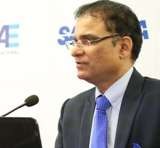
The conclave began with a welcome address by Dr. Arun Jaura, SAEINDIA Automotive Board Chairman followed by the Opening address by Dr. Aravind Bharadwaj, President, SAEINDIA.
Dr. AJ ….”Holistic deployment for next generation mobility will require agility, collaborative style of decision making, and a mindset change to proactively leverage innovative cross industry practices” stated Dr.Arun Jaura in his Introduction.

Dr. AB – “Business practices for next generation mobility will need a paradigm shift in building an innovation culture. Going forward, talent pipeline and ethics & values will form a stronger business foundation for faster growth” stated Dr.Aravind Bharadwaj in his welcome address.
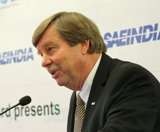
DH -….”Collaborative Innovation is a lever that will catalyze next generation business practices. Nurturing student initiatives along with supporting resources will build the appropriate pipe line for injecting fresh ideas in the mobility fraternity”
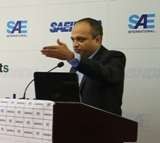
Dan Hancock set the tone for the evening by sharing his experiences on leveraging resources across borders, deploying cross industry technology and business practices. He discussed practices and success stories of Collaborative Innovation during his 43 years of work experience at GM in different parts of the world. Dan discussed STEM program and how that has made a big difference in the communities and mobility engineering fraternity in terns of nurturing S&T at a young age. He shared anecdotes of fund raising during the initial stages of these programs.
SB – …..”Radical innovation and disruptive thinking is key to the success of next generation mobility business practices. The sensitivity of customer needs across regions will help reverse innovation growth”.
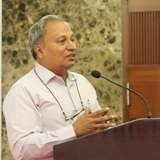
Suman Bose, MD and CEO, Siemens Industry Software India, talked about the need of a paradigm shift through disruptive thinking and radical innovation. He shared anecdotes of his teams’ efforts, the work being done in India and other regions on connected vehicles, and few other examples. How radical innovation and the way of conducting business has changed the play field for Siemens across India and the world, of course. He talked about technology trends since one size does not fit all, and various levers Siemens uses to be ahead of the curve in next generation mobility.
Dr M ”Holistic policies with industry blue prints and stronger partnerships with academia will streamline growth of next generation mobility industry. Emphasis on unique solutions in different markets will be even more prudent and need of the hour”
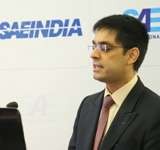
Dr. Mahadevan, Board Member of India Pistons Limited, shared his thoughts about a holistic approach and participation of stake holders, how setting the policy framework was important to lay a blue print for the industry and consumers of mobility solutions. The sustainability of mobility solutions requires more than knee jerk reactions of technology demonstrations. There was need for more research partnerships with academia and government R&D labs.
NS – ….”Sensitivity to regional markets will create a snowballing affect for the growth of global players in next generation mobility practices. Standards and practices need to be rationalized so that stake holders are aligned for a major mindset change”
Nirmal Shani, Director South Asia, IHS discussed the trends and practices IHS is tracking globally. How innovation platforms and partnerships within industry- academia has seen ideation growth in several regions of the world. Sensitivity to global needs is more important and decisions need to be made on the ground about a product or service rather than being thousands of miles away. Open Ideation and crowd sourcing are major trends in coming up with out of the box solutions.
The informal interactions after the formal session, revolved around alignment of stakeholders, radical innovation, socio-economic opportunities, agility in decision making and analysis at the grassroots level. How becoming global was important but being technologically savvy and innovative was even more critical as we embark on next generation sustainable mobility.


